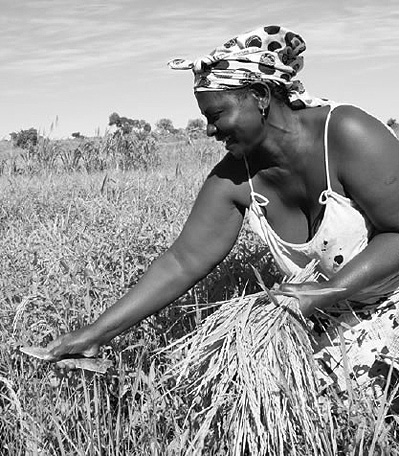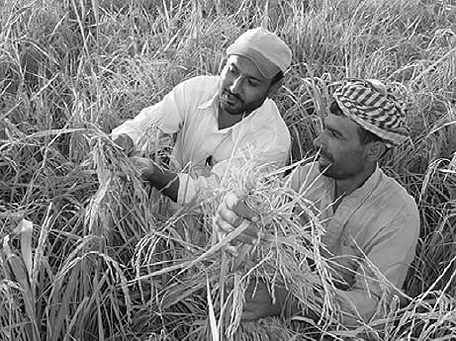Japan's Official Development Assistance White Paper 2011
(4) Agriculture
The population of the undernourished people still remains high, and grain prices tend to rise again. In such circumstances, efforts toward agricultural development are urgent issue toward the achievement of "eradication of extreme poverty and hunger," Goal 1 of the Millennium Development Goals (MDGs). In addition, three out of four poor people in developing countries live in rural areas. Because the majority of these individuals rely on farming for living, efforts to develop agriculture and rural communities are important, and measures to reduce poverty and achieve sustainable development through economic growth are required.
<Japan's Efforts>
As Japan's ODA Charter stated, Japan recognizes the importance of cooperation on agricultural efforts to poverty reduction and Japan is proactively striving to address food problems as a global issue (see page 84 for details regarding approaches to Food issues). In short term, Japan provides food assistance to avert food shortages, and in medium and longer term, in order to prevent and eliminate the cause of food shortages including hunger, Japan supports to increase and improve production and productivity in developing countries. Specifically, Japan uses its knowledge and experience to strengthen development and disseminate capacity of agricultural production technology suited to the cultivation environment, to strengthen organizations of farmers, and to assist policy-making as well as to improve the infrastructures like irrigation facilities and farm roads. In addition, Japan provides assistance for the research and dissemination agricultural technology of New Rice for Africa (NERICA)* in Africa. Further, Japan provides assistance in agricultural sector through the Food and Agriculture Organization of the UN (FAO), the International Fund for Agricultural Development (IFAD), the Consultative Group on International Agricultural Research (CGIAR), the UN World Food Programme (WFP), and other international organizations.

A Japan Overseas Cooperation Volunteer teaches planting vegetables to Nigerien women (Photo: Seico Tamai)
At a side event of the Fourth Tokyo International Conference on African Development (TICAD-IV) held in 2008, Japan announced the “Coalition for African Rice Development" (CARD*) initiative that aims at doubling African rice production in Sub-Saharan Africa from the original 14 million tons/year to 28 million tons/year over a period of ten years (see the figure on page 116 for details regarding TICAD). Currently, Japan is working with rice-producing countries in Africa and international organizations, to support the creation of individual rice development strategy for each of the 23 Sub-Saharan African countries, and is implementing projects based on that strategy.
In addition, at an expanded meeting on ensuring food safety in July 2009 G8 Summit in L'Aquila, Italy, Japan pledged at least $3 billion over three years in 2010-2012 for agricultural development including infrastructure. In particular, in order to assistance for reducing post-harvest loss* and promoting inter-trade and market distribution, Japan supports to transportation/storage and improvement of loading ports at the distribution stage, as well as development and management of water resources and agricultural land resources.

A woman harvests rice in the "Project for Improving Research Capacity for Nacala Corridor Agriculture Development" in Mozambique (Photo: Mika Tanimoto/JICA)
Terminology
*NERICA
NERICA (New Rice for Africa) is a general term for rice developed in 1994 by the West Africa Rice Development Association (WARDA; currently the Africa Rice Center) through hybridization of high-yield Asian rice with African rice, which is strong against weeds and disease and insect damage. Japan has also contributed to developing a variety of new types that are suited to the natural conditions of each region in Africa. The characteristics of the rice include (i) a higher yield, (ii) a shorter growth period, (iii) higher resistance to dryness (drought), and (iv) higher resistance to disease and insect damage, than conventional rice. Since 1997, Japan has partnered with international organizations and NGOs to provide support for research and development related to new types of NERICA, test cultivation, and increased production and popularization of seeds. In addition, Japan has dispatched agricultural experts and JICA volunteers (JOCV), and has received trainees from Africa for training in Japan.
*Coalition for African Rice Development (CARD)
CARD is a consultative group composed of donor countries, local African organizations, and international organizations partner with rice-producing countries in Africa that are interested in rice development. The CARD Initiative was announced at TICAD-IV in 2008. Japan plans to train 50,000 rice advisors in relation to doubling rice production.
*Post-harvest loss
Post-harvest loss refers to a loss of food that was actually harvested, due to harvesting at an inappropriate time, exposure to excessive rain or dryness, exposure to extreme heat or cold, contamination by microorganisms, or physical damage that decreases the value of the product, etc.
[Afghanistan]
"Improvement of Rice-based Agriculture in Nangarhar Province"
Technical Cooperation Project (September 2007 - March 2011)
Agriculture is a core industry in Afghanistan; approximately 80% of Afghans are engaged in agriculture. Rice is a particularly important grain, second only to wheat. However, the more than 20 years of war in the nation has destroyed irrigation facilities and systems to disperse cultivation technology. As a result, a quarter of the domestic rice demand is met through imports, spending scarce using precious foreign currency. Japan provided aid for rice cultivation in Nangarhar Province, Afghanistan's granary in the eastern rice-growing region, to improve the quality of rice and increase the income of farmers. Specifically, Japan provided guidance for agricultural techniques for agricultural experiment station researchers and agricultural dissemination staff members. Then, the station researchers and agricultural dissemination staff members teach farmers agricultural techniques on rice-growing to increase the volume of rice harvested. A method, tried on paddy crops, the nearly doubled the yielded from the range of 3 to 5 tons per hectare, to the range of 6 to 9 tons per hectare. Thus, further dissemination of the method is expected. In fact the "Rice-based Agriculture Development in Afghanistan" was launched in 2011 to implement the outcome results of this project in other rice-growing regions.

A dissemination staff member and a demonstration farm worker delight over the harvest (Photo: JICA)
